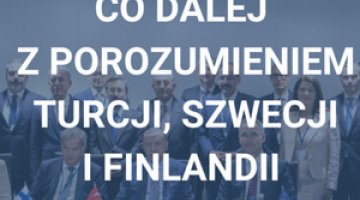Enforced cooperation: the Finnish-Russian migration crisis
On 22 March, during the President of Finland Sauli Niinistö’s visit to Moscow and his meeting with Russian President Vladimir Putin, agreements aimed at reducing the influx of migrants from Russian territory to Finland were signed. A large rise in the numbers of migrants seeking asylum at the northern section of the Finnish-Russian border (from September 2015 to February 2016) forced Finland to engage in talks with Russia in order to remedy the situation. The Finnish authorities feared that Russia was attempting to deepen the most serious migration crisis in the country in its post-war history by turning up the pressure from incoming migrants. The talks brought an abrupt end to the influx of migrants from Russia in March. In return for Russian cooperation over migration issues, Finland was forced to abandon its policy of limiting bilateral contacts with Russia, which it had adopted in response to the Russian intervention in Ukraine. It demonstrated the effectiveness of Russian strategy of persuading individual EU member states to seek accommodation with Russia bilaterally, thus weakening the EU’s ability to formulate and implement a common policy towards Russia. The opening and closing of the Arctic migration route leading via Russia to Finland was most likely a deliberate demonstration by the Russian authorities, designed to induce Helsinki into promoting the normalisation of relations between the European Union and Russia, and to show greater restraint in developing military cooperation with NATO and Sweden.
Finland on the influx of migrants from Russian territory
The migration crisis in Finland started in September 2015, when the Finnish-Swedish border in Lapland began to receive several hundred migrants a day. In parallel, there was an increase in the number of migrants at the two Finnish-Russian border crossing points between the Lapland region and the Murmansk oblast. Finland is a destination country for migrants due to its high social benefits and relatively short asylum procedures. Most of the applicants for asylum at the north-eastern border of Finland had not escaped directly from conflict sites, and had already resided in Russia for a long time. The crisis on the border of Finland and Russia escalated in January and February 2016, after Norway (which shares a 195 km-long border in its north with Russia, which has only one crossing) ceased to consider asylum applications from migrants with documents attesting to their legal residence on the territory of Russia. No influx of migrants to Finland was noted at the border crossings on the middle and southern parts of the Finnish-Russian border (which extends for more than 1300 km) – probably due to their economic importance for Russia (transit, tourism).
The increase in the number of migrants affects the rising terrorist threat and the influence of Islamic fundamentalists in Finland (according to Interior Ministry estimates, the country’s reception centres currently house several hundred people who have fought in the Middle East, including individuals who have committed war crimes in Iraq). This process is also boosting anti-immigrant sentiment, including regular attacks on reception centres, and the rise of extreme-right groups (such as the so-called ‘Soldiers of Odin’). While the flow of migrants across the border with Sweden was seen in Finland as part of a pan-European problem that requires a solution at the EU level, the migration across the border with Russia has caused greater concern, despite the small number of immigrants applying for asylum on the north-eastern border compared to the total number of asylum seekers in 2015 (2%). In February, Finland’s defence minister Jussi Niinistö warned that up to a million migrants from the territory of Russia could arrive on the Finnish-Russian border during 2016. Finland has begun to perceive the influx of migrants as a tool of Russian pressure on Helsinki, and as an element of Russian-Western tensions. It has also been interpreted as a Russian action calculated to test the efficiency of the Finnish administration, and of the Finnish public’s response.
Migration as an instrument of Russian foreign and security policy
In the Kremlin’s foreign policy instruments, the threat of directing migration flows has become a form of pressure which can be used to shape bilateral relations. The aim is to show that Russia has the ability to exacerbate existing problems by increasing the stream of migrants from its territory. Moscow wanted to demonstrate to Helsinki what the cost of prolonging the crisis in Russia’s relations with the EU would be, and to encourage Finland to take more active measures to normalise EU-Russian relations, particularly the lifting of EU sanctions. At the same time, Moscow has indicated that Finland’s current efforts to develop bilateral economic cooperation with Russia in areas not affected by the sanctions (including nuclear power and shipbuilding) are no longer sufficient. In addition, Russia’s warning is probably intended to discourage Finland from further strengthening its military cooperation with NATO, the United States and the Baltic Sea countries. Because the migration crisis is now at the centre of European policy, Moscow is using it to send a signal not only to Helsinki, but also to Brussels and other European capitals that it has the capacity to act against the interests of individual EU countries, force them to seek its cooperation, and thereby weaken the possibility of formulating and implementing a common and coordinated EU policy towards Russia.
The influx of migrants to the Russian borders with Norway and Finland could not have happened without the supervision of Russian security services. The migration route leading to the north-west of Russia runs through a zone of special military interest (particularly the Murmansk region), and is under the security services’ constant supervision. This rules out the free movement of the migrants, or the unsupervised activities of criminal people-smuggling groups. The Russian authorities also bear the responsibility for the corruption in state institutions (diplomatic posts, functionaries of the Foreign Ministry and the Federal Migration Service) which issue documents allowing entry and residence on the territory of Russia. Asylum seekers in Finland (and Norway) mostly hold documents certifying the legality of their stay in Russia (tourist visas or temporary work permits).
Cooperation ‘under the gun’ of migration
In the face of an increasingly difficult situation at both border crossings, in December 2015 the government of Juha Sipilä decided to try and stop the flow of migrants by holding bilateral talks with Russia, without resorting to resolve the problem within the framework of the European Union. This approach was caused not only by problems with the readmission of migrants denied asylum in Norway to Russia, but also with the historical background to Finnish-Russian relations, inherited from the times of the cold war, namely the conviction of the need to seek bilateral solutions to contentious issues. Such an approach, however, does not apply to the area of defence policy, where Helsinki has decided to develop its cooperation, mainly with NATO, the US and Sweden. Several months of Finnish-Russian talks – at the levels of the two countries’ migration services, Ministries of the Interior (the heads of the interior ministries met this January and set up a joint working group of law enforcement agencies dealing with illegal migration) and Prime Ministers (Sipilä met Medvedev this January) – resulted in a halt to the influx of migrants from the territory of Russia at the beginning of March this year. At a meeting of Presidents Niinistö and Putin (22 March), representatives of the Finnish Ministry of the Interior and Russian Federal Migration Service signed two agreements; on restrictions on border traffic at two Finnish-Russian crossings in Lapland (limiting traffic to citizens of Finland, Russia, Belarus and members of their families; the agreement will be valid for up to 180 days from the date of its entry into force), and on countering illegal migration. However, the agreements may prove to be only a temporary solution to the problem, since their implementation is dependent on the will of Russia, and there is a risk that the migratory pressure can be resumed.
Appendix
Migrants in Finland
In the years 2014-2015 Finland increased the number of refugees it accommodates as part of the UNHCR’s quota system from 750 to 1050 people annually. However, it was unprepared for the unprecedented increase in the number of asylum seekers in 2015, when the number of asylum applications amounted to 32,500 (nine times more than in 2014). 63% of the people in this group are citizens of Iraq; 16% Afghanistan, 6% Somalia, 3% Syria. On the Finnish-Russian border in the Lapland region (the Salla/Raja-Jooseppi crossing point) 700 asylum applications were lodged in 2015, and a further 1000 in January-February 2016 (mostly from citizens of Afghanistan; other large groups were made up of citizens of India, Syria and Bangladesh). To limit the number of people seeking asylum, Finland has announced a reduction in benefits, and intensified its efforts to return migrants from Iraq, Somalia and Afghanistan to their countries of origin under bilateral agreements. At the same time, however, it has pledged to adopt 3200 refugees from Greece and Italy, and 600 from Turkey, in accordance with the European Commission’s proposals.
Migrants in Russia
According to data from the Federal Migration Service (FMS) on migration to Russia, the number of illegal migrants resident in Russia (this number includes those whose documents have expired) is showing a downward trend (in relation to 2014) and amounted to 1.5 million people at the end of 2015 (of whom 800,000 had been there for over a year). It is emphasised that illegal migration in Russia is mainly economic in nature. There have been no alarms regarding an increase in the number of migrants from war-stricken Syria; according to the FMS, the number of Syrians resident on the territory of Russia is estimated at 11,000 people, and citizens of Afghanistan at 8000.





